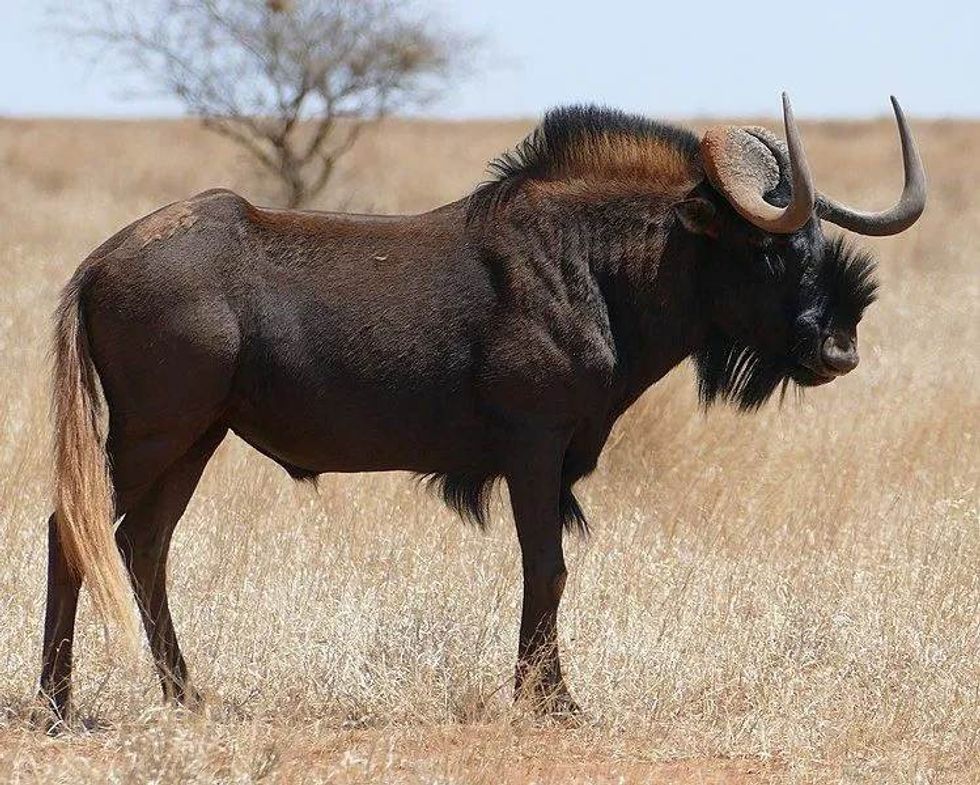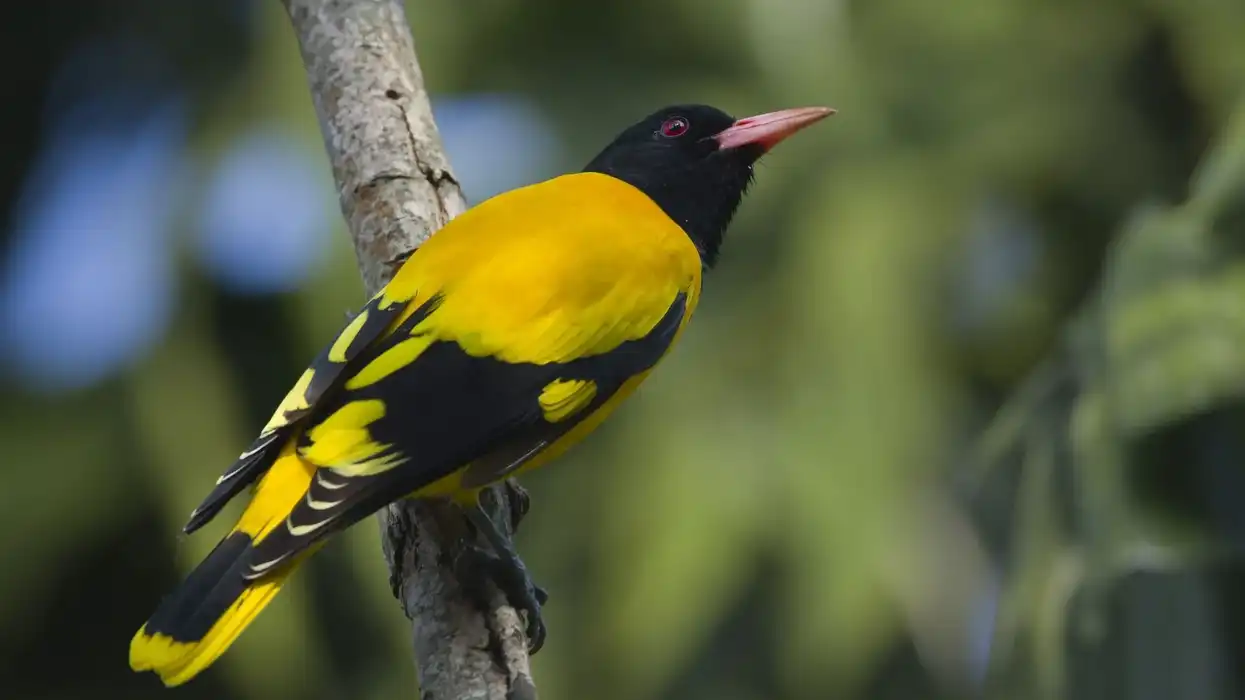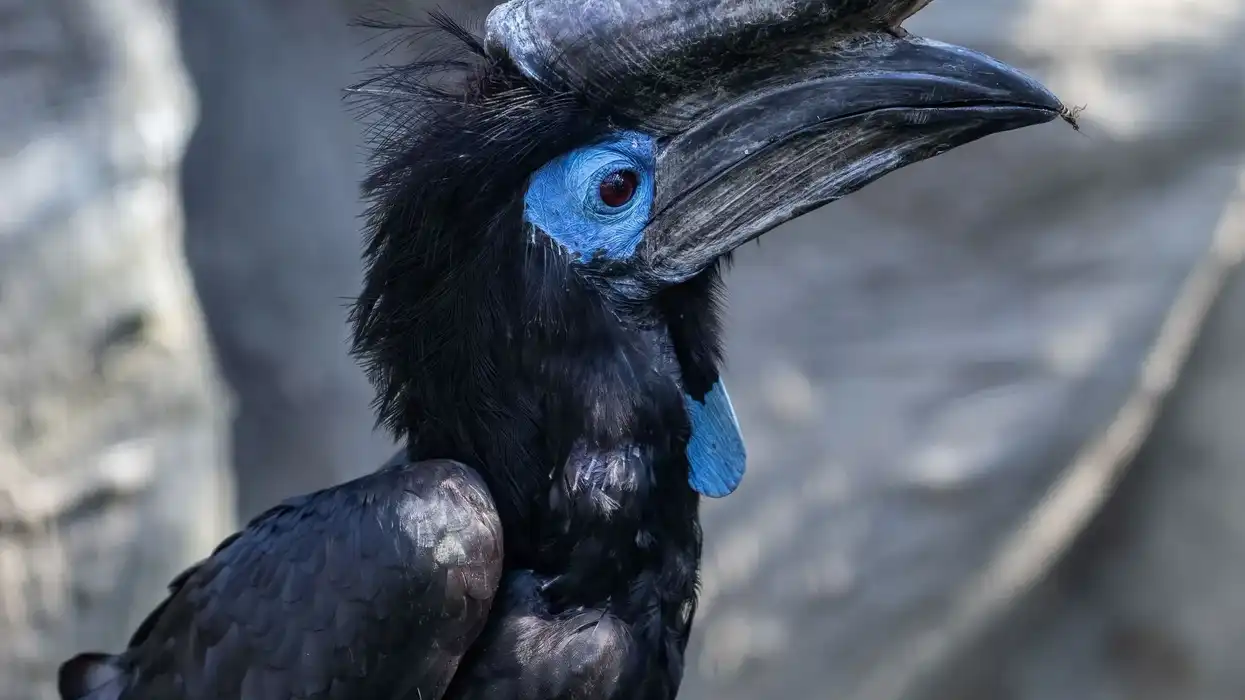A black wildebeest is not to be mistaken for a beast! The black wildebeest, scientifically known as Connochaetes gnou, belongs to the genus Connochaetes of the family Bovidae. The word 'konnos' in Greek means 'beard', and 'gnou' indicates the repetitive 'ge-nu' honking call.
They are one of the two closely related wildebeest species. They belong to the family of antelopes such as deer and topi. These mammals are mainly endemic to the open grass habitats of southern Africa.
They move in herds in a single file and graze in loose groups. They are predominantly herbivores and are active during the early hours and the eleventh hour. They are also called white-tailed gnu for their fluffy whitetail.
Mountain Zebra National Park, Golden Gate Highlands National Park, and the Mokala National Park are populated with many wildebeests herds.
Continue reading for more interesting black wildebeest facts, or check out our other articles on surely the dik-dik and the axis deer.
Black Wildebeest Interesting Facts
What type of animal is a black wildebeest?
The black wildebeest is a large antelope with distinct features. It belongs to the genera Connochaetes.
What class of animal does a black wildebeest belong to?
Connochaetes gnou is a mammal and it belongs to the class Mammalia.
How many black wildebeests are there in the world?
The total population of these black wildebeests of the genus Connochaetes is 18,000, of which Namibia has 7000 individuals.
Where does a black wildebeest live?
These wildebeests or white-tailed animals are endemic to southern Africa. Historically, they are indigenous to South Africa, Lesotho, and Swaziland. But later, when their population start to decline, the species was reestablished in Namibia. These animals are found in grasslands and shrublands.
What is a black wildebeest's habitat?
As prominent gazers, these animals occupy or locate themselves where short grass is in abundance. They also graze at shrubs, so they are predominantly confined to open plains, grasslands, and South African Karoo shrublands. Their home ranges stretch up to 0.39 sq mi (1 sq km).
Who do black wildebeests live with?
The black wildebeest is a gregariously social animal. It has three unique social structures which include female herds (usually 14-32) with adults and their yearlings, a male bachelor herd of young and old males, and herds of territorial bulls.
The female is closely associated with other animals in herds, whereas, the bachelor herds are not. Young herds serve as a refuge for the males who lose to dominant bulls and breeding males.
How long does a black wildebeest live?
The lifespan of this wildebeest or white-tailed species is 20 years in its wild habitat range and can be 22 years in captivity.
How do they reproduce?
The mating season of this white-tailed gnu species can be anywhere from the rainy season to February and April. Although the male acquires sexual maturity at the age of three or less when in captivity, females are estrus as early as the yearling age of two and are fertile only once in the year.
The supreme male that leads the harem of females does not concede the females to other males. He constantly focuses on the herd and mates several times with the particular estrus females throughout the breeding season.
During this time, they display courtship behavior like ritual urination, sniffing the female's reproductive organs, and stretching low, touching the rump section of the female with his chin. The females tend to position their tail upwards or splash it all over the male's face.
The breeding pair splits post-mating. During the mating period, the male is least focused on food and sleep, resulting in a deviation and might mount over other males.
The female delivers a single calf after a gestation period of almost eight and a half months. During labor, females stay within the herd and take rest, and get up at regular intervals.
For labor, they prefer short grass, and the cow delivers in a lying position. 80% of the births occur two or three weeks after the rains, from mid-November through December.
The calf has a dusky and furry coat with 24 lb (11 kg).
What is their conservation status?
These black wildebeests are listed as a species of Least Concern by the International Union for Conservation of Nature, hence they are not Endangered. The species became Extinct in the natural range of South Africa in the 19th century due to extensive hunting, with a few remaining at the zoos.
From there, the population was revived by introducing this species in Namibia which yielded successful results. And now, most of their herds are restricted to protected game farms.
Black Wildebeest Fun Facts
What do black wildebeests look like?
This species of wildebeests display sexual dimorphism. Their length ranges from 67-87 in (170-220 cm). Males can be as tall as 44-48 in (111-121 cm), and females are around 42-46 in (106-116 cm). The weight of males typically ranges from 309-397 lb (140-180 kg) and 243-269 lb (110-122 kg) in females.
Both sexes have a significantly bright white-colored tail which is as long as that of a horse. As a result, this animal is also called a white-tailed gnu. The tail is 31.5-39 in (80-100 cm) long.
The black wildebeest fur coat is dark brown or black. It is paler in summer and coarse and shaggy during winter. Females are less dark than males. A bushy, white, or cream-colored, dark-tipped mane sticks up from the neck.
The calf has shaggy, fawn-color fur. It has black bristly hair over the muzzle and under the jaw. In between its forelegs is long dark-colored hair. It has small beadlike eyes, a plain back, and a thick neck.
Hooks like strong horns curve forward in both the sexes, resembling hooks, which are 31 in (78 cm) long. In males, the horns sit on a flattened protective shield, and also the male horns are broad at the base.
In females, horns are short and narrow. The horns are fully developed by the third year in females and age four or five in males. The thoracic region of this antelope can become elongated and could have 13 or even 14 (recorded) thoracic vertebrae.
The black wildebeest has scent glands that secrete a glutinous substance. This secretion is found near the eyes, on the forefeet, and below the hair tufts.
The two teats of females excrete for milk production.
How cute are they?
This wildebeest of Africa is a large and fast-moving antelope with smart techniques to escape from predators.
How do they communicate?
These wildebeests communicate among themselves through pheromone chemical secretions, which are excreted due to flehmen's response.
They also use vocal calls like an echoing hick or a metallic snort for communication. Their calls are audible up to a distance of 1 mi (1.5 km).
They perform challenge rituals during territorial fights, an act where the bulls constantly interlock their heads.
This species displays sexual behaviors during mating.
How big is a black wildebeest?
This species, Connochaetes gnou, on average, is 67-87 in (170-220 cm) in length and 42-48 in (106 -121 cm) tall, which is slightly lesser than that of the wildebeest Connochaetes taurinus which stands 59 in (150 cm) tall.
How fast can a black wildebeest move?
The white-tailed gnu being an antelope can run as fast as 50 mph (80 kph). The wildebeests have fast-twitch fibers that help them to run at high speeds without fatigue.
How much does a black wildebeest weigh?
This wildebeest black of South Africa is sexually dimorphic in size. The male weighs in the range of 309-397 lb (140-180 kg), and the female weights between 243-269 lb (110-122 kg).
What are their male and female names of the species?
The male and female black wildebeest are known as a bull and a cow, respectively. A group of these animals is called a herd.
What would you call a baby black wildebeest?
A baby C. gnou is called a calf.
The calves are born mostly in the rainy season and try to remain close to their mothers.
What do they eat?
This species of antelope, Connochaetes gnou, are herbivores. The availability of short grasses accomplishes 90% of their food. If its primary diet is unavailable, they pick shrubs and herbs to compensate for it. Another fundamental element is water to this C. gnou. They require water to survive but do not require it daily.
These animals are hunted by predators, including spotted hyenas, lions, cheetahs, leopards, crocodiles, Cape hunting dogs, or painted wolves.
Are they dangerous?
When approached by humans, they repeatedly run away for a few hundred meters, snorting. They physically may not harm humans but can carry diseases like lungworms, ticks, and tapeworms.
Would they make a good pet?
The black wildebeest is kept at zoos but is not adopted as a pet.
Did you know...
Wildebeest are not aggressive, quite contrary to their appearance. They avoid being provocative and are threatening only during mating season.
In general, a wildebeest can live up to 22 years of age.
The skull of a black wildebeest weighs around 4 lb (1.8 kg).
Black wildebeest vs. blue wildebeest
The difference between blue and black wildebeest is evident in their physical anatomy like fur coats, tails, horns, and size. For example, male blue wildebeests weigh 551 lb (250 kg) and females weigh 397 lb (180 kg), while male black wildebeests weigh 309-397 lb (140-180 kg), and females weigh 243-269 lb (110-122 kg).
The black wildebeest has a white tail, while the tail of the blue wildebeest is black. Black wildebeests are also darker and smaller than the blue wildebeest.
Black wildebeests have horns that curve forward first, again towards down, then curve upwards at the tip, whereas, in the wildebeest, Connochaetes taurinus horns grow sideways then curve downwards to curve up towards the skull.
The black wildebeest fur coat is brown colored with a mane which could be cream to black. The blue wildebeest (wildebeest Connochaetes taurinus) has a dark gray color fur coat mixed with shiny blue, with occasional stripes.
The blue wildebeest inhabits woodlands and grasslands, while the black wildebeest is restricted to only open grasslands. Likewise, blue wildebeests migrate over long distances, while the black does not.
The milk of black wildebeests is high in protein, low in fat, and contains low lactose compared to blue wildebeests.
Do black wildebeests sleep?
When in hot weather or in a shadeless habitat, black wildebeests prefer to feed mainly at night and so, they do not sleep during the nights. During cold climates, these animals rest lying on the ground, and in hot weather, they rest while in a standing posture.
Also, in general, during mating seasons, these wildebeests do not sleep in excitement.
Here at Kidadl, we have carefully created lots of interesting family-friendly animal facts for everyone to discover! Learn more about some other mammals from our giant sable antelope facts and highland cattle facts pages.
You can even occupy yourself at home by coloring in one of our free printable Black wildebeest coloring pages.









